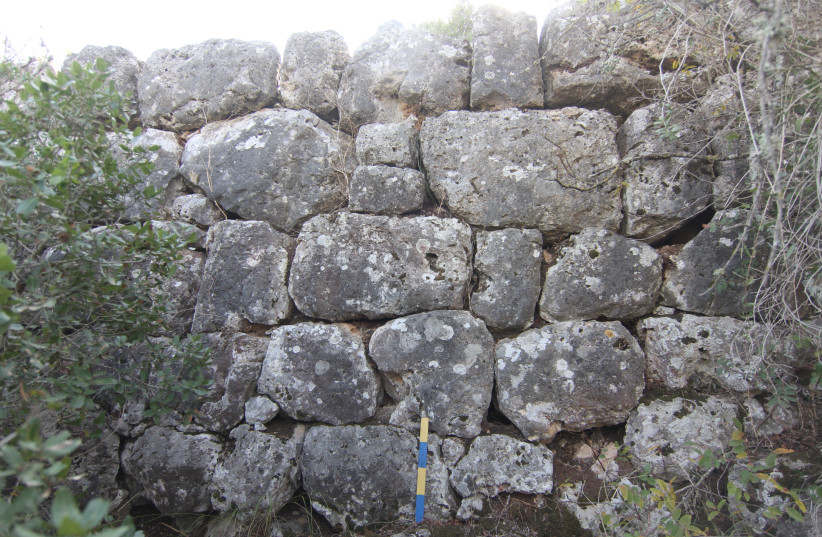The massive fortification ruins of Horvat Tefen are located in a secluded spot on a prominent hilltop in the Western Galilee overlooking Acre. It is very likely hikers trekking along the path across the ruins are completely unaware that they may well be walking past a unique part of Galilee history: a military fortress built by Hasmonean King Alexander Jannaeus in the early first century BCE.
In a paper published in the May issue of the Bulletin of the American Schools of Oriental Research (BASOR), a peer-reviewed academic journal of the ancient Near East, Hebrew University of Jerusalem archaeology graduate student Roi Sabar suggests that these ruins were actually a short-lived fortress that was a part of a string of military strongholds built by Jannaeus near the end of his reign, to consolidate control over the expanded territory he had conquered.
Similar fortresses attributed to Alexander Jannaeus’s fortification of his territory have recently been excavated in the Galilee and in the area east of the Jordan River valley called Transjordan in the Bible, Sabar said.
“This is something we do not hear about in historical text,” he said. “The architectural remains, layout of the site and archaeological evidence all indicate that Horvat Tefen was a short-lived military site founded by Alexander Jannaeus in the last years of his reign, to protect the borders of his kingdom at the height of his territorial expansion. It was abandoned shortly after.”
The ruins at Horvat Tefen include seven rectangular towers built without mortar from large field stones of various shapes and sizes, connected by solid walls along the edge of the relatively leveled hilltop. The largest tower is 11.5 by 18.5 meters, and the smallest is five meters by 7.5 meters. Most are divided into chambers inside. The width of the supporting walls ranges from almost one meter to 1.6 meters, and their length ranges from nine meters to 44 meters.

The fortress’s location on a naturally fortified hilltop far from water resources, main routes and farmland also clearly points to a military function rather than an agricultural one, Sabar wrote.
“Such hilltop locations are typical of Hellenistic-period sites in the region and for fortresses or fortified estates of the Hasmonean Dynasty in Judaea and Transjordan,” he said.
While several surveys of Horvat Tefen were conducted in the late 19th century as well as in 1962 and the 1980s, Sabar’s 2019 dig on behalf of the Hebrew University is the first excavation at the site.
The background
The Hellenistic period was a one of warfare, as the Ptolemaic and Seleucid armies fought over territory, with the Seleucid kingdom ultimately going into decline in the second half of the second century BCE. Several local groups, including the Nabateans, the Itureans, the Phoenicians and the Hasmoneans, began vying for control in the region.
By the end of the century, the area, known as Ceole-Syria, had been carved up. The Hasmoneans took over the greater part of the Galilee, though they were still facing off with the Phoenician city of Akko-Ptolemais for domination.
Originally, it had been thought that the Horvat Tefen fortress may have been part of this struggle, Sabar said.
The Hasmonean king defeated the people of the city in a field battle in 103 BCE, ancient historian Josephus Flavius said in the only written account mentioning the area of Akko-Ptolemais during the reign of Jannaeus. However, he failed to take over the city after the Phoenicians called for assistance from Ptolemy IX (Lathyrus) from his exile in Cyprus. For his part, the Ptolemaic heir, taking advantage of local events, had cast his eyes on Egypt and was hoping to capture the throne from his mother, Ptolemaic queen Cleopatra III in Alexandria.
According to Josephus’s account of the battle, Jannaeus was defeated by Lathyrus, and Cleopatra III eventually invaded the region and took over the city of Akko-Ptolemais herself.
“Before [our excavation], I thought the fortress was part of this strategy,” Sabar said. “But our excavations show that it is a later period. It surprised me very much because I was sure that the fortress was built before [Jannaeus], and he came and conquered it. But the finds show this is not true.
“I suggest that the fortress is a part of the end of Alexander Janneaus’ rule when he fortified the extended territories he has conquered.”
Roi Sabar
Based on the material finds uncovered at the site, including ceramic vessels, glass, and 50 coins from the time of Jannaeus, Sabar said the initial phase of the site should be dated to around 85-76 BCE, and the foundation of the fortress attributed to the Hasmoneans.
The vast majority of the pottery recovered from the excavations is dated to the Late Hellenistic period.
There is very little data about the material culture of the Hasmonean period in the Galilee, Sabar said in his paper, mainly because most of the Hasmonean sites were occupied continuously through the Roman and Byzantine periods.
“The finds at Horvat Tefen are therefore unique in their well-defined chronological frame, and shed important light on the material culture of the early first century BCE – the early decades of the newcomers from Judea to the Galilee,” he said.
